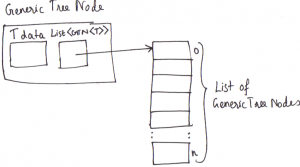This project is available on github. Please download from there to make sure you have the latest version.
Last week I was solving a problem at work that required the use of a Generic (n-ary) Tree. An n-ary tree is a tree where node can have between 0 and n children. There is a special case of n-ary trees where each node can have at most n nodes (k-ary tree). This implementation focuses on the most general case, where any node can have between 0 and n children. Java doesn't have a Tree or Tree Node data structure. I couldn't find any third-party implementations either (like in commons-lang). So I decided to write my own.
First, we need to define the node of our tree. Our node has two attributes. One is the data, and another is a List which can contain references to the children of that node:

The code for a Generic Tree Node looks like this:
GenericTreeNode.java
import java.util.ArrayList;
import java.util.List;
import java.util.regex.Matcher;
import java.util.regex.Pattern;
public class GenericTreeNode<T> {
public T data;
public List<GenericTreeNode<T>> children;
public GenericTreeNode() {
super();
children = new ArrayList<GenericTreeNode<T>>();
}
public GenericTreeNode(T data) {
this();
setData(data);
}
public List<GenericTreeNode<T>> getChildren() {
return this.children;
}
public int getNumberOfChildren() {
return getChildren().size();
}
public boolean hasChildren() {
return (getNumberOfChildren() > 0);
}
public void setChildren(List<GenericTreeNode<T>> children) {
this.children = children;
}
public void addChild(GenericTreeNode<T> child) {
children.add(child);
}
public void addChildAt(int index, GenericTreeNode<T> child) throws IndexOutOfBoundsException {
children.add(index, child);
}
public void removeChildren() {
this.children = new ArrayList<GenericTreeNode<T>>();
}
public void removeChildAt(int index) throws IndexOutOfBoundsException {
children.remove(index);
}
public GenericTreeNode<T> getChildAt(int index) throws IndexOutOfBoundsException {
return children.get(index);
}
public T getData() {
return this.data;
}
public void setData(T data) {
this.data = data;
}
public String toString() {
return getData().toString();
}
public boolean equals(GenericTreeNode<T> node) {
return node.getData().equals(getData());
}
public int hashCode() {
return getData().hashCode();
}
public String toStringVerbose() {
String stringRepresentation = getData().toString() + ":[";
for (GenericTreeNode<T> node : getChildren()) {
stringRepresentation += node.getData().toString() + ", ";
}
//Pattern.DOTALL causes ^ and $ to match. Otherwise it won't. It's retarded.
Pattern pattern = Pattern.compile(", $", Pattern.DOTALL);
Matcher matcher = pattern.matcher(stringRepresentation);
stringRepresentation = matcher.replaceFirst("");
stringRepresentation += "]";
return stringRepresentation;
}
}

This looks great! Just added to my project… you’re a life saver Vivin!
How do we get parent of a child ?